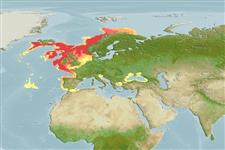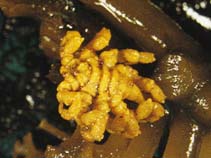Pycnogonida |
Pantopoda |
Pycnogonidae
Environment: milieu / climate zone / تغييرات عمق / distribution range
بوم شناسي
; تغييرات عمق 0 - 1262 m (مرجع 2007). Subtropical; 78°N - 30°N, 72°W - 37°E
Northern Atlantic, Arctic Ocean and the Mediterranean.
Length at first maturity / Size / Weight / سن
بلوغ: Lm ? range ? - ? cm
Proboscis: Attached relatively large animals such as actinians or sponges. Cuticle (covering the proboscis): May be smooth, partly, or wholly covered with tubercles. Proboscis (tip): Small and buld-like, once inserted in the host tissues they close round it and help to anchor the mouth in position to maintain suction. Mouth at the tip of the proboscis: triadiate structure which usually has three lip-lobes with a number of small tubercles (Ref. 12). Feeding on hosts: hydroid Tealia crassicornis, by suction and rasping of jaws,Lucernaria, Cucumaria frondosa, Metridiumdianthus and Metridium senile (Ref. 233, 229); polyzoans rotting edges of Flustra foliaces (Ref. 234); Milne-Edwardsia loweni, Tealia crassicornis, Lucernaria, Cucumaria frondosa, Metridium dianthus, Metridium senile, and Cynthia. Method of feeding: insertion of proboscis into tissues of the host (Ref. 233, 229). Association with other animals: Clava multicornis, Actinia, Tealia, Metridium,and Alcyonarium digitatum (Ref. 213); polyzoan Flustra foliacea (Ref. 12). Development site of larval associations: Clava multicornis with proboscis inserted (Ref. 213). Reproduction system: ova ripen in the trunk part of the ovary. Life cycle: male rests for a long period on the back of the female with their genital orifices touching. These orifices are situated on the ventral surface of the second coxa of the last pair of legs in the male and on the dorsal aspect of the same leg and segment in the female. When eggs are released they forma single extensive ball in this species with both ovigerous legs embedded in it (Ref. 12).
Epibenthic (Ref. 87524). Littoral (Ref. 1797) from coastal to slope (Ref. 19). Feeding on hosts, i.e., sea cucumbers, tunicates and hydroids and hard corals (Refs. 229, 233, 234) by inserting proboscis into tissues of the host (Refs. 233 and 229). Free-living (Ref. 3123). Prefers anemones Calliactis sp. and Adamsia sp. over Actinia sp. and Tealia sp. as its host. Reported one case where it fed on the holothurian Cucumaria frondosa (Ref. 121217).
Life cycle and mating behavior
بلوغ | تولید مثل | تخم ریزی | Eggs | Fecundity | Larvae
Reproduction system: ova ripen in the trunk part of the ovary. Life cycle: male rests for a long period on the back of the female with their genital orifices touching. These orifices are situated on the ventral surface of the second coxa of the last pair of legs in the male and on the dorsal aspect of the same leg and segment in the female. When eggs are released they form a single extensive ball in this species with both ovigerous legs embedded in it (Ref. 12).
مآخذ اصلی
مراجع | هماهنگ كننده | همكاران
Bamber, R.N. and M.H. Thurston 1995 The deep-water pycnogonids (Arthropoda, Pycnogonida) of the northeastern Atlantic Ocean. Zoological Journal of the Linnean Society. 115:117-162. (مرجع 1797)
وضعيت در فهرست قرمز IUCN
(مرجع 130435: Version 2025-1)
وضعيت از نظر سايتس (مرجع 108899)
Not Evaluated
Not Evaluated
خطر برای انسان ها
استفاده انسانی
| FishSource |
ابزارها
اطلاعات بيشتر
Population dynamicsرشد
Max. ages / sizes
Length-weight rel.
Length-length rel.
نوسانات طولی
Mass conversion
فراواني
Life cycleتولید مثلبلوغFecundityتخم ریزیEggsنمو تخمLarvae PhysiologyOxygen consumption
Human RelatedStamps, coins, misc.
منابع اينترنتي
Estimates based on models
Preferred temperature
(Ref.
115969): 4.1 - 11.3, mean 8 (based on 132 cells).
طبقه قيمت
Unknown.




